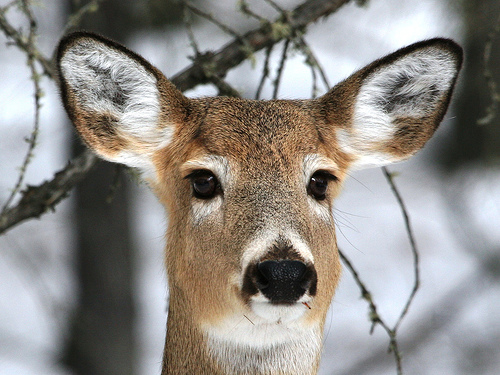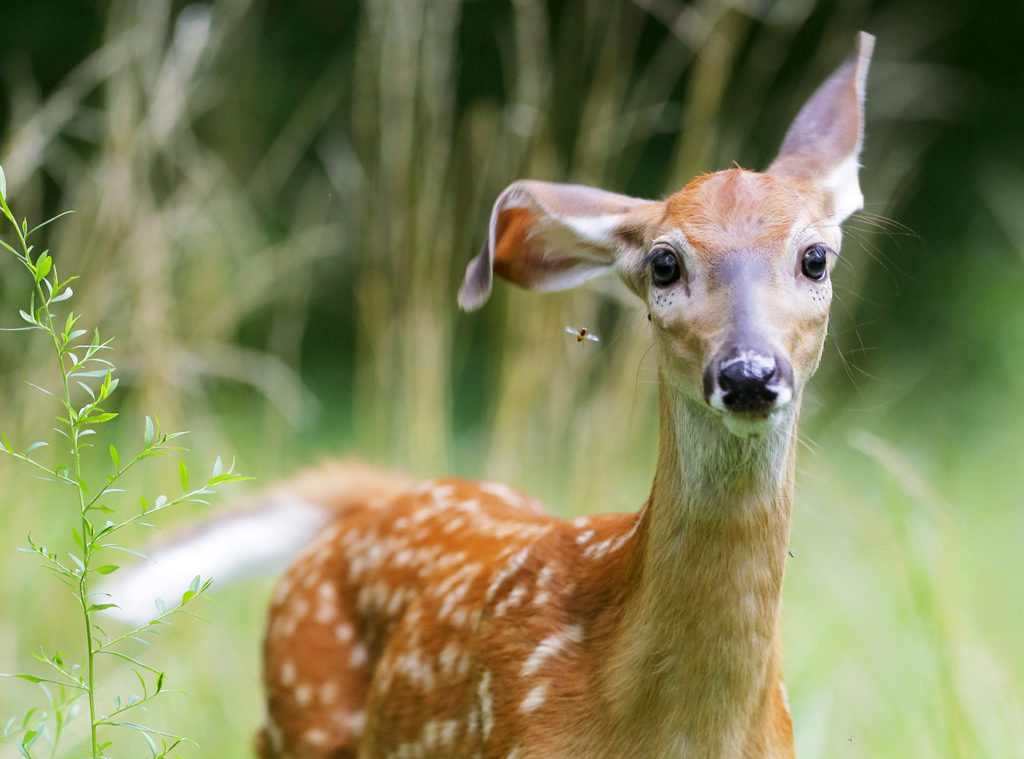31 Jan WHAT DEER HEAR?
Hunters know that the ears of a deer can swivel and locate specific sounds. These directional antennae can pinpoint a hunter well beyond a hunter’s hearing range. Throw in a deer’s excellent vision and super sense of smell, and it makes you wonder how hunters have any chance at harvesting these amazing critters.

Human hearing and deer hearing are surprisingly similar. Recent research has shown what makes the deer’s hearing so effective is their ability to hear in a 360-degree circle. Deer constantly swivel their ears. They can also move their ears in different directions at the same time. Human ears are fixed so we hear to the side and ahead of us. Sneaking up behind is another matter. Deer hear best in the levels of their vocalizations. 1-8 kHz is the range of 12 primary deer vocalizations. Human hearing is best from 2-5mHz. Both deer and humans can hear from .25-20 kHz. Deer are best at pinpointing the sounds direction and can interpret what it is.
Natural sounds are comfortable to a deer. Sticks breaking, shuffling leaves, other critters noises, etc. Much of their hearing sounds like dead noise or soft static. This constant buzz or hum is the background noise that they can tune out. The intensity and level of sound is what gets the deer’s attention. Even though the deer can hear from .115 kHz -54 kHz, but they can also hear sounds over 90 decibels and up to 64 kHz. Deer can hear high frequency sounds better than humans.

Since humans are Predators and deer are prey, these findings make sense. The Predators eyes are fixed forward as are their ears. Deer are always on the defense, in order to survive and avoid predators. Since deer only age to 7-8 years or so, they maintain good hearing throughout their lives. Humans lose their hearing over a lifetime. Younger hunters have stronger senses than older ones.
Normal or routine noises do not bother deer. Interpreting sounds that are a threat is a huge advantage. Squirrels, falling limbs, geese, neighbor dogs, and routine sounds will not put deer on alert. Deer know what they are supposed to hear. They can filter out the routine normal background noises.
Humans are the same. As a schoolteacher, I worked in buildings with hundreds of screaming students. Certain noises were quickly identified as a threat. The sounds of kids fighting, agitated kids, unusual sounds, or sometimes no sounds would alert me to an issue or problem.
The sounds of a gun, bow twang, are heard by the deer. They will instinctively react to the noise that is unique or different. This is similar to how a human reacts when a sound suddenly scares you. Some of us jump, do a little dance, drop to our feet, or turn and run. Deer do the same.
Arrow travels at about 260-325 feet per second, depending upon how you have them set. At 20 yards, the deer can drop its body 10 inches by the time the arrow gets there. You can easily miss a deer over 20 yards due to this example. Sound travels way faster than an arrow.
Rifles shoot at 1200 fps – over 3000 feet per section. The faster the projectile, the less time or reaction from the deer. Add string silencers and gun noise suppressors and range will increase.
The speed of sound is 1,125 feet per second, which is 767 miles per hour, or a mile in 4.7 seconds. It is possible that a deer can easily hear a hunter at over half a mile, in normal conditions. They can smell you even further away.
One evening I was hunting in a ridge top tree stand. My view was amazing. Another group of hunters pulled up over a mile away. I could hear the slam of their doors, and voices as the got ready to hunt. I watched them through my binoculars when suddenly here come several deer. This group of deer had already heard the unusual and specific dangerous noises and were headed into the next county. Those noisy hunters never had a clue. The hunt begins at the car or vehicle. Never underestimate what a deer can hear, see, or smell.
A fed deer is a dead deer. Feeding deer is a problem. I am not a supporter of baiting or feeding wild deer. Hunters become reliant on food attractants and lose, or never learn, real hunting skills. Hunters that bait are lazy! People that feed wild deer in their yards will love them to death. Deer can live in small and crowded neighborhoods and become conditioned to noise and being fed, until they aren’t. The sound of an electric deer feeder turning on at 4 o’clock can bring them in right on time.
Populated areas are full of human noises and danger noises. Deer can determine which are which until the temptation of a baited buffet becomes too much to resist. What were once danger sounds have become “normal”. Dogs barking, cars and trucks, and other danger signals become commonplace and deadly. Nose to nose contact, over bait piles, spreads diseases. Deer can starve to death with a belly full of baited corn. Deer, and all wild critters, need to hear and fear humans, and other dangers and predators to survive
Hunting near natural foods is another matter. One day I was hunting near a White Oak tree that was full of acorns. Every time the wind blew, acorns were falling, and deer were coming to the dinner bell. None of deer would come into range. What if I could call them in by mimicking falling acorns? Fortunately, I remembered carrying chocolate Malty Balls that were about the same size.
Malty Balls are one of my favorite deer hunting snacks. Anyway, I grabbed a few from my pocket and when the wind blew, I chucked a few toward the area with my best bow shot opportunity. They sounded like acorns hitting the leaves. Sure enough, a buck lifted his head and walked 75 yards toward the exact spot where the Malty Balls fell. He never had time to taste one. It cost me a few candies but what a treat.
A deer will hear you 3 times, see you twice, but smell you once! Deer and hunters must trust their ears. Identifying direction and what made the sounds are also critical. Our noses, eyes and instincts are also important. The one thing about being a successful deer hunter is that there is not just one thing!
I hope you heard me loud and clear!
Montana Grant
For more Montana Grant, hear more at www.montanagrantfishing.com.


